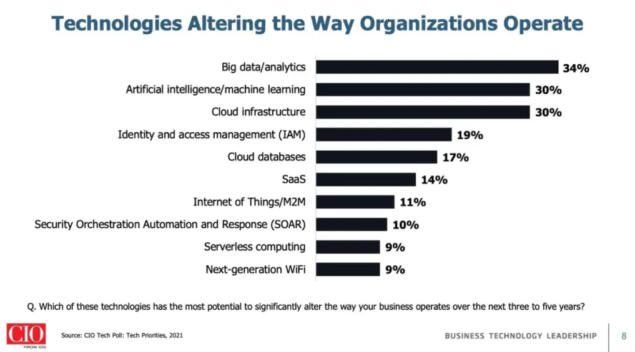Contactpersoon
Jeffrey Bos
Director NL
)
The government sector is well known for being built on legacy systems and to this day, still heavy on manual and paper processes. Known for their frugal technology spend tendencies, government organizations need a way to modernize the way they operate from their internal processes to the external user interfaces that citizens use to request services and information, all while containing costs associated with digitization.
As government entities work to plan and execute this transformation, there are a plethora of new technologies to be considered as part of the overall strategy, but several challenges unique to this sector will make it interesting.

Government is said to be among the least digitally mature sectors, with correspondingly lower busines transformation success rates. Generally speaking, this sector has less experience in agile approaches and is often very restricted by legacy technologies.
With so many public sector services requiring an in-person appearance, the remote lifestyle imposed by the pandemic put many government entities in a tough position and accelerated their move toward being able to offer a more digital citizen experience.
As Deloitte points out in this article, many government organizations made progress and became “wired” but did not actually transform. There is still too much focus on digitizing front-end services while they put off the bigger issues that require a more wholistic re-engineering of their operations, processes and systems.
But for those who have invested the time and budget into a fundamental operations overhaul, it is undoubtedly paying off. Seventy-seven percent of government agencies report that business transformation initiatives pushed during the pandemic are already having a positive impact on their organization.
As an example of digitization efforts paying off, The Tennessee Department of Human Services (DHS) was struggling to deliver timely customer service as they were hamstrung by siloed channels and manual processes. Wait and resolution times got to be way too long.
They looked for a technology solution to help them transform the customer experience, simplify and accelerate service delivery, unify workflows, share information, and deliver the insights management needed to make data-driven decisions. Using ServiceNow’s Customer Service Management (CSM), inquiry assignment time went from 36 hours to 100 seconds, and more importantly, they cut inquiry resolution times by 70%.

Government agencies should have a business transformation strategy that is built around three pillars – migrating (and hopefully eliminating some) legacy apps, creating automation and establishing visibility. These three pillars will transform the customer (citizen) experience while achieving operational efficiencies that drive down costs.
Migrating legacy apps into the cloud (and onto a single system of everything) is not a small task, but here’s a simple 5-step article to get you started on a plan.
The focus of a migration away from legacy applications should be on case management, whereas this consumes most of the workload in government agencies. Government organizations are getting by – slowly and inefficiently – with a plethora of old and siloed point systems that were all implemented at different times for different purposes. This landscape should be replaced with a Case Management as a Service (CMaaS) approach that uses a “modular” and unified (single-source of truth) case management system that can be quickly built, tailored and changed to be dynamic with constantly changing business needs.
It should be even more beneficial – for both operational efficiencies and citizen experience – if the different types and levels of municipal, state and federal or other government entities manage cases on the same platform (all connected to the same master data source).
he public sector is a prime candidate for the automation that comes with business transformation for a couple of reasons. So much of what government entities do is case management and administrative tasks. Huge amounts of energy are expended on those essential administrative tasks, which are highly exposed to automation technology.
The lack of automation in government operations today is directly correlated with citizen experience challenges. For some reason, the government sector is one place where customer satisfaction isn’t exactly the primary driver of their investments and strategy. Case in point: A ServiceNow study found that among all agency processes, the least automated service was resolving customer issues.
In that same study regarding the state of automation in today’s federal agencies, it was found that:
The drastic need for automation provides government entities an opportunity, though: instead of looking at the impending talent shortage (it’s estimated that 20% of the workforce across many states is eligible to retire) as a threat, they should instead identify every opportunity to automate administrative tasks instead of jumping to replace headcount to carry out the motions of inefficient, manual task execution.
Of all technologies, big data and analytics is the biggest factor altering the way organizations will operate. This is certainly true for government organizations where visibility of systems performance and data trends from a single platform will play a key role in providing a higher level of service for a better citizen experience – and at a reasonable cost.

Consolidating functions and data into one single-view platform will lead to lower operational costs, and happier citizens with easy-to-consume government services.
An example of how digitalization will make life easier for government entities while also providing better citizen services could include the handling of an incident where traffic lights lose power on a busy intersection. Instead of a reactive approach where the city is notified via a civilian calling in to report the issue (or a traffic accident), the systems tracking connected traffic lights are able to proactively identify the criticality and alert personnel immediately to prompt corrective measures.
Another example of the same (where 360 degree visibility helps both operations and the customer experience) could be immediate notification to the government organization who oversees an online motor vehicle services portal that is malfunctioning. Let’s say an error code pops up every time a citizen tries to request an appointment to renew their license. In normal times, the physical office would get an overflow of angry people who tried (unsuccessfully) to complete the task online but had to go to the physical location upon the system malfunctioning. In pandemic times, however, this wouldn’t have been possible in many places. So, in this scenario of an incident left unattended to, citizens would have no way to renew their license to legally operator a motor vehicle (what an inconvenience!).
Relating to all three objectives above, and a very important foundational piece of government services modernization, is the onset of Citizen Digital Identity. Digital identify is the notion of having one universal, digital and secure system for easily identifying an individual through any government channel. This should make completing tasks easier and faster for both consumers of government services, and the government employees who are carrying out a task that requires identity of a citizen.
Digital identity ecosystems are developing fast and governments will play a significant role in this space. Gartner predicts that a global identity standard will emerge in by 2024, so government agencies should immediately begin to incorporate this concept into their roadmap and use cases.
Starting with a small-scale project helps organizations achieve quick wins to get rolling (and gain cultural buy-in). The business transformation roadmap should start with identifying goals and objectives tied to a desired outcome for one specific process or function at a time. It’s also important to factor in current/ongoing IT initiatives into your business transformation roadmap, and ensure there is an established and agreed upon prioritization list for all of them combined.

The ServiceNow platform can help government agencies go from doing digital things, to being a digital operation. It has the power to drive real change by automating and eventually scaling the delivery of services on a single, secure and unified platform. Simply put, it can quickly provide government agencies with automation (increased productivity), visibility, and security — at a much lower cost than government agencies are currently incurring with legacy systems.
The platform provides a best-practice service model that defines, structures, and automates the flow of work for mission and business applications, replacing inefficient or manual processes with streamlined service delivery.
With ServiceNow, governments can consolidate legacy tools to a single, easy-to-use service management platform in the cloud (or on-premise) to accelerate the modernization of operational processes and customer experience. This shift will significantly cut costs, or shift them from maintenance to innovation, depending on the agencies digital aspirations.
Plat4mation is an elite ServiceNow partner who major global brands call on to realize the full potential and maximize value from their ServiceNow platform investments.
Being a pure-play partner and a smaller boutique firm, we’re known for our specialized knowledge of Now Platform capabilities and a true-partner approach, where we work closely with our customer to understand and define objectives, and quickly produce results to validate the approach before scaling up.
We’ve completed several successful engagements with government agencies around the world and taken that experience to 1) develop a deep understanding of the unique requirements of a government entity business model, 2) identify symmetries between the government services model and ServiceNow platform capabilities, and 3) develop a vast library of reusable assets, integrations and methodologies unique to operational processes of this sector.
In this position, we’re able to quickly understand objectives and present more wholistic and future proof solutions, as well as complete projects efficiently, and on time.